Steps to fix Windows computer that randomly wakes up to check for updates
Fortunately, you don't have to worry too much - fixing this error is really easy. TipsMake will teach you how to fix errors so that your PC won't wake up abnormally to check for updates.
1. Override the MoUSO Core Worker process
The MoUSO Core Worker process (MoUSOCoreWorker.exe) arranges Windows update sessions in the background. That's pretty important, but if the process keeps waking up the PC randomly, you can override it so it won't be annoying.
Following are the steps to override the MoUSO Core Worker process:
Step 1: Press Win + R to open the Run dialog box.
Step 2: Type CMD and then press Ctrl + Shift + Enter to open CMD with admin rights.
Step 3: Type the following command and press Enter:
powercfg /requestsoverride process MoUSOCoreWorker.exe execution
When the process is complete, close Command Prompt and then restart the PC to save these changes.
2. Turn off the computer wake-up timer
The wake timer on your PC could be the reason why you're having this problem. So let's see how you can turn them off to prevent your PC from waking up randomly:
Step 1: Press Win + R to open the Run dialog box.
Step 2: Type control.exe powercfg.cpl,,3 and then press Enter to open the Power Options window.
Step 3: Click the Sleep drop-down menu and then select Allow wake timers.
Step 4: Next, click the On battery and Plugged option, select Disable from the drop-down menu.
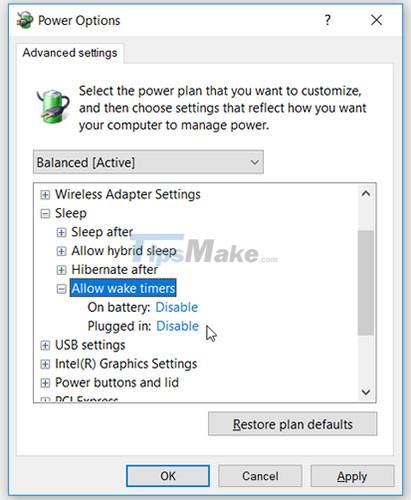
When done, click Apply and then OK to save these changes.
3. Configure some settings in Task Scheduler
PCs are more likely to wake up randomly based on the settings you have configured in the Task Scheduler. So let's see how you can tweak some of the Task Scheduler's settings to solve the problem:
Step 1: Press Win + R to open the Run command dialog box.
Step 2: Type taskchd.msc and then click OK to open Task Scheduler.
Step 3: On the left pane, navigate to Task Scheduler Library > Microsoft > Windows > UpdateOrchestrator.
Step 4: Next, right-click the Schedule Scan task in the middle and select Disable.
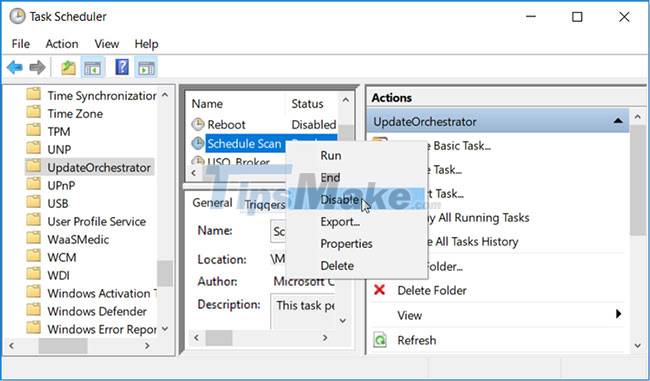
Finally, close the Task Scheduler window and restart the device.
4. Turn off Update Orchestrator Service and Windows Update Service
To prevent your PC from randomly checking for updates, you can disable the Update Orchestrator Service and Windows Update Service. Here's how you can do this:
Step 1: Press Win + R to open the Run command dialog box.
Step 2: Type services.msc and then click OK.
Step 3: Locate the Update Orchestrator Service, right-click it, then select Properties.
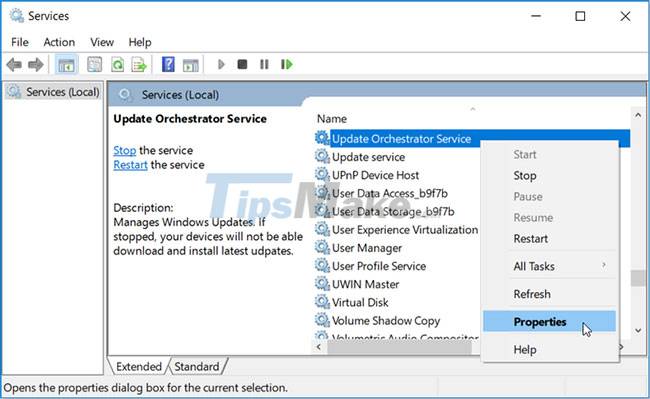
In the next window, select Disabled in the Startup type drop-down menu, then click the Stop button.
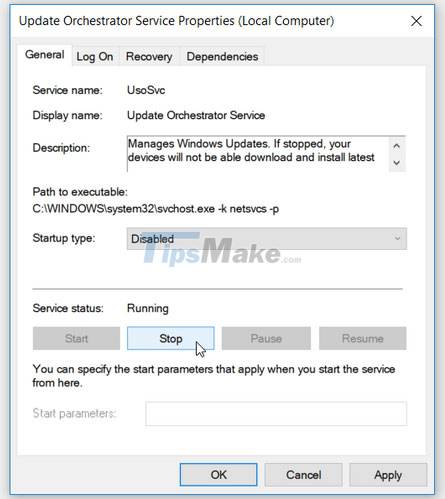
Click Apply and then OK.
When you are done, right click on Windows Update Service then disable it similar to the previous steps. Finally, restart your PC to save these changes.
5. Restore default power settings via Command Prompt
In some cases, this problem can be caused by the way you have configured the power settings. If you're not sure which settings you should edit, resetting the power settings to default can help.
Here's how you can restore your PC's power settings via Command Prompt:
Step 1: Press Win + R to open the Run dialog box.
Step 2: Type CMD and then press Ctrl + Shift + Enter to open Command Prompt with admin rights.
Step 3: Type the following command and press Enter:
powercfg -restoredefaultschemes
When the process is complete, close Command Prompt and restart the device.
6. Run Windows Update Troubleshooter and Power Troubleshooter
Since this is a 'system update' and 'source' issue, the Windows Update troubleshooter and Power troubleshooter can be helpful.
First, let's see how you can run the Windows Update troubleshooter:
Step 1: Navigate to Start menu > PC Settings > Update & Security, then click Troubleshoot in the left pane.
Step 2: Scroll down on the right pane, click the Windows Update option, then click the Run the troubleshooter button. Follow the on-screen instructions to complete the process.
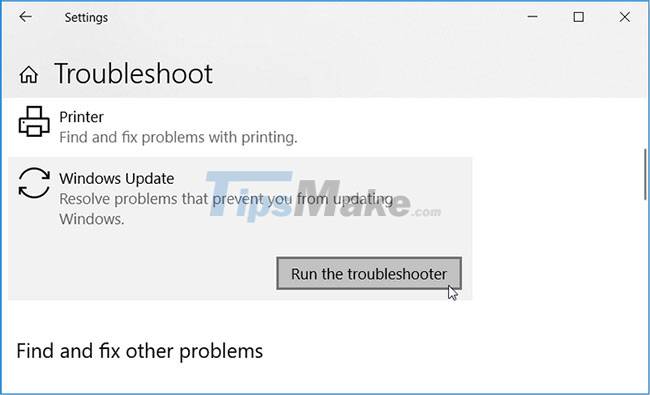
Next, here's how you can use the Power troubleshooter to solve the problem:
Step 1: Find the Power troubleshooter, click it, then click Run the troubleshooter.
Step 2: Follow the on-screen instructions to complete the process and then restart your PC when it's done.
7. Pause Windows Updates
Pausing Windows updates can also help with this problem. Refer to the article: How to turn off Windows Update on Windows 10 for more details.
8. Activate Metered Connection
By default, Windows does not automatically check for updates over a Metered Connection (a type of internet connection with limited data). In this case, you will have to manually check for updates if you want to upgrade your PC.
9. Edit Windows Registry
You can easily solve this problem by editing a few keys in the Windows Registry. But since you'll be dealing with sensitive information, it's best to start by backing up the Registry. That way, you'll be safe if anything goes wrong.
Now, here's how you can solve the problem through Registry Editor:
Step 1: Press Win + R to open the Run dialog box.
Step 2: Type Regedit and then click OK to open Registry Editor.
Step 3: Navigate to:
HKEY_LOCAL_MACHINE > SOFTWARE > Policies > Microsoft > Windows > WindowsUpdate > AU
Step 4: Double-click the NoAutoRebootWithLoggedOnUsers value on the right side to edit it.
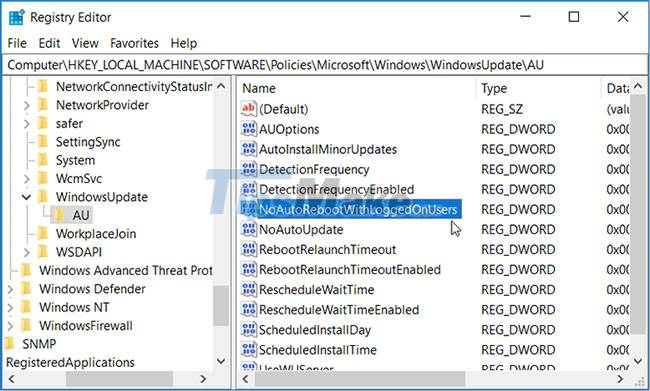
In the next window, set Value data to 1 and then click OK.
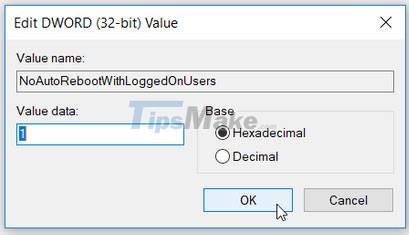
If there is no NoAutoRebootWithLoggedOnUsers value, here's how you can create it:
Step 1: Navigate to the AU key/folder following the previous steps and then right click in the empty space on the right hand side.
Step 2: Select New > DWORD (32-bit) Value and then name the new value NoAutoRebootWithLoggedOnUsers.
Step 3: Double-click the value, set Value data to 1, then click OK.
Step 4: When you're done, close Registry Editor and restart your PC.
Here are some ways to help prevent your PC from suddenly waking up and asking for an update. Hope they help you!
Hope you are succesful.
You should read it
- Steps to uninstall updates on Windows 10 and Windows 11
- Microsoft warns, clicking Check for Updates will make the new Windows 10 update unstable
- Update Windows software
- How to hide Windows Update on Windows 10
- Fixing errors Windows Update Service or BITS Service is missing on Windows Service
- Instructions for updating on Windows 11
 How to fix 'Critical Structure Corruption' blue screen error on Windows 10
How to fix 'Critical Structure Corruption' blue screen error on Windows 10 What to do if BIOS cannot detect ATA/SATA hard drive in Windows?
What to do if BIOS cannot detect ATA/SATA hard drive in Windows? Steps to fix activation error code 0xC004F074 on Windows
Steps to fix activation error code 0xC004F074 on Windows How to fix error 0x0000011b when printing over the network on Windows 10
How to fix error 0x0000011b when printing over the network on Windows 10 Steps to fix ASUS laptop with sound
Steps to fix ASUS laptop with sound How to fix error 0x803f8001 on Windows 10
How to fix error 0x803f8001 on Windows 10